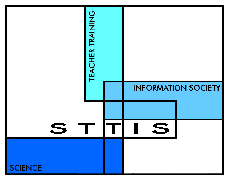Workshop 1
 Contents Contents
|
Section
E Transformations: values
Activity
E1 Computer modelling and values |
|
Aims
-
To consider ways in which
the use of computer modelling
may be transformed by teachers.
-
To explore factors related
to personal values that
may influence the transformations.
-
To consider these issues
in the light of your own
teaching experience.
Background
Our actions are guided by what
we see as important
and what we value. Often, we may not make our values explicit, but they
have an effect all the same. When teachers described their work on
computer
modelling, they referred to personal values about what should be in the
curriculum and how it should be taught in the classroom. What kinds of
experiences should pupils have in learning science and what kinds of
understandings
about science do we want them to have? Can computers distort pupils’
images
of science? Should computers be seen as a tool for learning science or
should they be seen as a part of science itself? The following stories
address these questions.
[N.B. These stories are based
on research into the work of teachers implementing the use of computer
modelling. Though they are not based on particular individuals, they do
focus on issues that were identified in the research.]
What to do
1. It is best to do
this activity in a group
of two or three. Before you start discussion, however, work
individually
and read through each of the stories on page
2.
For each story, decide whether you are:
-
broadly sympathetic to the
position outlined in the
story (S)
-
broadly unsympathetic to
the position outlined in
the story (U)
-
neither (N)
Write the appropriate letter
next to each story.
2. Discuss
each story in turn within the
group. It may be useful to think about the following:
-
What is the key idea of
the story?
-
Are there points that the
teacher makes that we all
agree with?
-
Are there points that the
teacher makes that we all
disagree with? If so, is this because we disagree in principle or
because
we think the teacher has said something factually incorrect? Or because
they say something which may apply in their own situation but not in
yours?
-
What are the issues where
we do not reach a consensus?
What are the reasons for this?
3. After discussion,
work individually again
and look back over all of the stories. Pick out a few key sentences,
which
you agree with and think address the most important ideas for you.
Underline
them. Pick out a few sentences that you disagree with strongly.
Underline
them in a different colour or style. (Make a note of what the
colours/styles
mean so that you can work it out later.) You will be returning to these
sheets in a later session. |

 Teaching with computer models
Teaching with computer models

